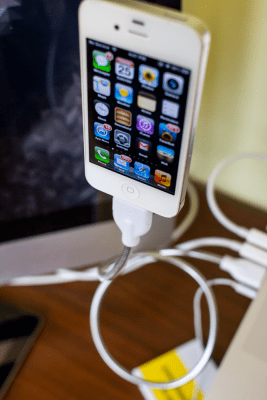Kickstarter is a place I regularly turn to for hardware accessories, mostly because I’m often bored by the safe bets being put out there by the general crop of hardware makers. But all too often lately, I find myself running into a problem, one that seems endemic to the Kickstarter way of doing things: accessories I back are often useless by the time they ship.
Case in point: I received my Une Bobine today (pictured). It’s an articulating iPhone charge and sync cable that’s strong enough to hold the iPhone 3GS, 4 or 4S aloft so that you can use it as an additional screen with your computer setup, without having a dock or other stand nearby. It’s cool, and it works well. But I backed it in June, only a few weeks before the idea of a redesigned dock connector started getting passed around the web. So basically pre-ordered in June, and it arrived in September, just in time to be made obsolete.
That’s actually a relatively fast turnaround time for a hardware Kickstarter project, and I commend Une Bobine’s team for staying mostly on track and delivering a solid product. But it’s an essential, non-trivial problem with the Kickstarter model and device accessories, one that’s happened before and will happen again, with things like the Geode from iCache (delivery was originally estimated for April, now says iPhone 5 version will be available, but further delays anticipated), the Syre (a Bluetooth iPod nano watch case that won’t work with/is unnecessary for new iPod nano with built-in Bluetooth), and maybe worst of all, the Orbit (dual suction cup iPhone stand that probably won’t work with the aluminum backing, and was supposed to ship in December of 2011).
Did I mention the hundred or so docks, clocks and more that are designed to be used with the 30-pin connector? Cause there are those, too. Here’s a thing like that, and another, and yet another one. All of these had shipping dates that were much earlier than now, so consumers could reasonably have expected to get some use out of the things before change came. The best among them are now offering upgrade paths for people switching to iPhone 5, but not everyone is doing that. And as always with Kickstarter, there are no guarantees.
Upgrade cycles for consumer electronics are getting shorter, not longer, with Samsung the most notable to begin stepping up the pace with which it releases new tablets and smartphones. Apple’s on a pretty rigid yearly system, but even that’s too short a period for a lot of small manufacturers just getting started with the intricacies of building a supply chain and manufacturing process.
Many will say that I’m just too eager to upgrade my devices, and that’s true, I’m the edge case example of an early adopter. But who do you think is using Kickstarter to pre-order exciting new accessories? Probably not the same people who are happy to pick up an iPhone 4 almost three years after it was originally introduced. Kickstarter actually adds a whole new dimension of “early” to the concept of early adopter, one that can very accurately be described as on the bleeding edge of new tech.
If I count up how many products I’ve backed have actually shipped, and then take that number and subtract the ones that my primary hardware has outpaced, it makes me very sad. On the other hand, Kickstarter is not a shopping mall; it’s an investment platform that carries inherent risk. But consistently running into issues with products that are out of date by the time they ship could have a long-term, net negative effect on backer appetites, not to mention the problems it generates in terms of building long-lasting customer relationships. Bottom line, this is a serious issue that project planners would do well to address up front, with clear plans for what happens when a product feels dated before it even arrives.
